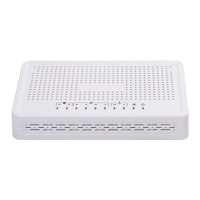ESR series service routers.ESR-Series. User manual
Step Description Command Keys
28 Set IP/IPv6 router address that will be
used as source IP/IPv6 address in
transmitted BGP route information
updates (optional).
esr(config-bgp-neighbor)# update-
source { <ADDR> | <IPV6-ADDR> }
<ADDR> – source IP address,
defined as AAA.BBB.CCC.DDD
where each part takes values of
[0..255];
<IPV6-ADDR> – source IPv6
address, defined as X:X:X:X::X
where each part takes values in
hexadecimal format [0..FFFF].
<IF> – interface specified in
form given in theTypes and
naming procedure of router
interfaces section of CLI
command reference guide.
<TUN> – tunnel name specified
in form given in the Types and
naming procedure of router
tunnels section.
29 Enable the mode in which the reception
of routes in the BGP attribute, AS Path
of which includes the numbers of
process stand alone system, is allowed
(optional).
esr(config-bgp-neighbor)# allow-
local-as <NUMBER>
<NUMBER> – threshold
amount of instances of
autonomous system number in
the AS Path attribute at which
the route will be accepted, the
range of acceptable values
[1..10].
30 Enable the BFD protocol on the
configured BGP neighbor (optional,
used in conjunction with the update-
source parameter).
esr(config-bgp-neighbor)# bfd-
enable
31 Specify neighbor authentication
algorithm (optional).
esr(config-bgp-neighbor)#
authentication algorithm
<ALGORITHM>
<ALGORITHM> – encryption
algorithm:
md5 – password is encrypted
by md5 algorithm.
32 Set the password for neighbor
authentication (optional).
esr(config-bgp-neighbor)#
authentication key ascii-text
{ <CLEAR-TEXT> | encrypted
<ENCRYPTED-TEXT> }
<CLEAR-TEXT> – password, set
by the string of 8 to 16
characters;
<ENCRYPTED-TEXT> –
encrypted password of 8 to 16
bytes (from 16 to 32
characters) in hexadecimal
format (0xYYYY ...) or
(YYYY ...).
33 Make neighborhood active. esr(config-bgp-neighbor)#enable

